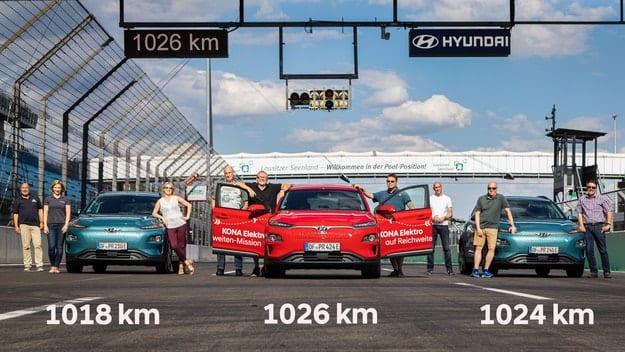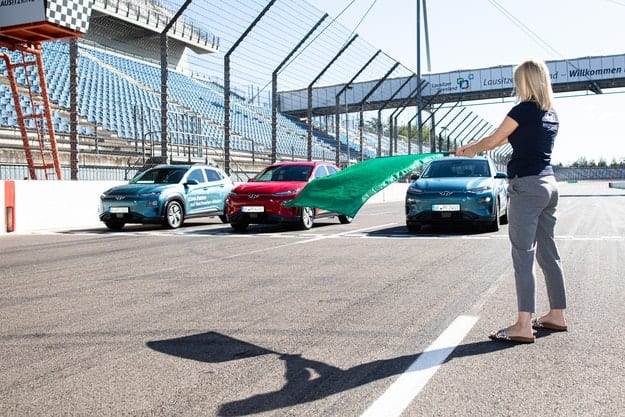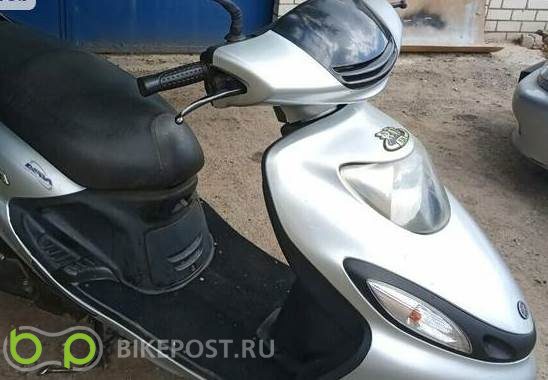
Hyundai KONA Electric sets mileage record
Content
Three KONA Electric models, in line with Hyundai Motor's vision of EV, set a record mileage per charge for the company's electric vehicles. The task was simple: with one battery charge, each car had to travel more than 1000 kilometers. The all-electric subcompact crossovers passed the test, also known as "hypermilling," with ease to a fully discharged battery after 1018 km, 1024 km and 1026 km. In terms of battery capacity of 64 kWh, each test vehicle set another record, as the energy consumption of vehicles at 6,28 kWh / 100 km, 6,25 kWh / 100 km and 6,24 kWh / 100 km is significantly lower. the standard value is 14,7 kWh / 100 km, set by the WLTP.
The three KONA Electric test vehicles were fully production SUVs when they arrived at Lausitzring, with a WLTP range of 484 km. In addition, three urban SUVs with 150 kW / 204 hp. were driven by co-drivers during their three-day testing, and vehicle assistance systems were not used. These two factors are also important prerequisites for the importance of the Hyundai lineup. Dekra, the expert organization that has led Lausitzring since 2017, ensures that everything goes according to plan in a successful attempt to maximize efficiency. Dekra's engineers made sure everything went smoothly by tracking used vehicles and keeping records of each of the 36 driver changes.
Energy-saving driving as a challenge
Since no other manufacturer has conducted such a practical test, preliminary estimates have been appropriately conservative. Hyundai technicians working with Thilo Klemm, head of the After-Sales Training Center, calculated a theoretical range of 984 to 1066 kilometers to simulate average speed driving within a city. This was a challenging task for the teams as driving in an energy-efficient manner required concentration and patience in the summer. In Lausitzring, three teams competed against each other: a team of test drivers from the renowned industry magazine Auto Bild, one with technical specialists from Hyundai Motor Deutschland's sales department, and another team consisting of employees from the company's press center and marketing department. While the use of air conditioning was not banned, neither team wanted to risk the fact that an air-conditioned ride and outside temperatures up to 29 degrees Celsius could melt crucial kilometers. For the same reason, the KONA Electric infotainment system remained disabled throughout, and the available power was used only for driving. Only the daytime running lights remain on as required by road traffic laws. The tires used were standard low resistance tires.

On the eve of the record-breaking test, Dekra engineers checked and weighed the condition of all three KONA Electric models. In addition, the specialists compared odometers and glued the on-board diagnostic interface, as well as a protective cover under the dashboard and above the trunk lid in the front bumper, in order to exclude any manipulation of the result. Then the nearly 35-hour journey began. Then the Hyundai electric fleet moved along it carefully, whispering quietly. During a driver change, things get more lively when topics such as cruise control settings, display of current onboard fuel consumption and the best, i.e. The most efficient way to approach bends on a 3,2 kilometer track is to get busy. In the early afternoon of the third day, the first warnings from cars appeared on the display. If the battery capacity drops below eight percent, Hyundai KONA Electric's on-board computer recommends connecting the vehicle to the mains. If the remaining battery capacity drops to three percent, they will go into emergency mode, reducing full engine power. However, this did not affect the drivers, and with 20% residual capacity, the vehicles still managed to cover more than XNUMX kilometers while driving efficiently.
Customers rely on KONA Electric
“The mileage mission shows that KONA Electric's high-voltage batteries and high-powered electronics go hand in hand,” Juan Carlos Quintana, head of Hyundai Motor Deutschland, said at a press conference. "It's also important that all three test vehicles covered almost the same number of kilometers." Another important finding during the test was that the Hyundai KONA Electric charge level indicator is very reliable and measures percentages depending on the driving style. At zero percent, the car continues for a few hundred meters, then it runs out of power and finally comes to a halt with a slight shake because the electric parking brake is activated for safety reasons. “I congratulate everyone involved in this mission, which has proven that our KONA Electric is affordable and highly efficient,” said Michael Cole, President and CEO of Hyundai Motor Europe. “This lifestyle-focused vehicle combines the attractive design of a compact SUV with the benefits of an environmentally friendly vehicle. This means that every KONA Electric customer will purchase a vehicle with a range of technologies suitable for everyday use.
Hyundai KONA Electric is Hyundai's best-selling electric model in Europe
The result is confirmed by the expansion of KONA Electric's production at the Czech Hyundai Motor Manufacturing (HMMC) plant in Nošovice, Czech Republic. HMMC has been producing an electric version of the compact SUV since March 2020. This allows Hyundai to dramatically reduce waiting times for new EVs. And this has already been rewarded by buyers. With nearly 2020 units sold in 25000, it is one of the best-selling all-electric models and the best-selling electric SUV in Europe.

